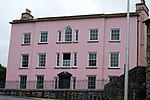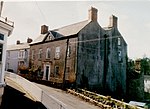Island House, Laugharne

Island House is a Grade II* listed, partly Tudor, sub-medieval townhouse located in Laugharne, Carmarthenshire, in southwest Wales. It sits below the castle between the two mouths by which the River Corran enters the Tâf estuary, known locally as "Earth Lake" and "Mill Orange". The frontage now ranges along Wogan Street but was formerly set in a walled garden. Built principally of stone, the earliest parts date from the 15th century, with additions from the 16th and 19th centuries. The grading status signifies a building of exceptional interest and it is the oldest residence in the township. The historic importance of whole site is shown by separate listings of its garden, walls and outbuildings.Laugharne was a seaport from the early Middle Ages and the first owners of Island House traded goods from the adjoining Gosport Harbour at the head of the Corran navigation. It could then shelter 350-ton vessels but capability slowly declined as the inlet's tidal prism was reduced by siltation at the basin entrance. Eventually an extensive saltmarsh developed across the foreshore and by 1950 the ancient channels were no longer passable and now only provide moorings for recreational craft.
Excerpt from the Wikipedia article Island House, Laugharne (License: CC BY-SA 3.0, Authors, Images).Island House, Laugharne
Wogan Street,
Geographical coordinates (GPS) Address Nearby Places Show on map
Geographical coordinates (GPS)
| Latitude | Longitude |
|---|---|
| N 51.7696 ° | E -4.4634 ° |
Address
Select Convenience
Wogan Street 3
SA33 4TB , Laugharne Township
Wales, United Kingdom
Open on Google Maps








